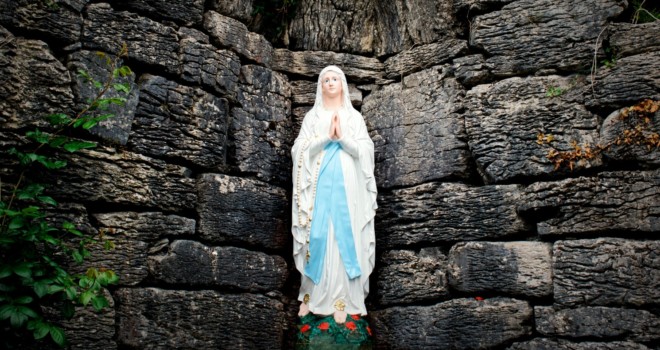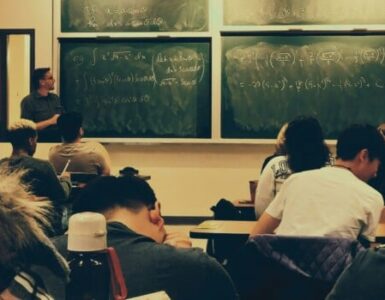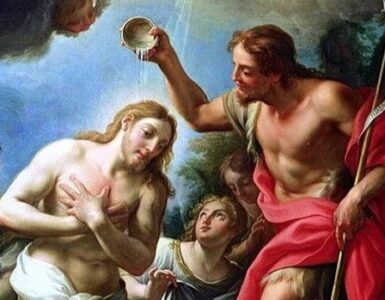As a seminarian studying in Rome, the Postulants formed a group to get to know and love Mary, the Mother of God. Our group read a short but excellent apostolic exhortation by Pope Paul VI: Marialis Cultus—the Cult of the Virgin Mary. It took us several sessions to end our sharing and discussion on the document. However, we all derived many positive fruits.
Given that I was just in the initial stages of my priestly formation, the document proved to be a solid ecclesial teaching. However, of equal importance, because I was preparing to become a Religious priest of the Oblates of the Virgin Mary, this document proved to be of enormous importance in helping me understand and live my charism which is to love Mary, live out a Marian consecration, and promote Marian devotion as catechist, preacher and teacher.
Mother of the Church
The Second Vatican Council placed Mary in a special place in the overall ecclesial context, proclaiming Mary to be The Mother of the Church. Venerable Fulton Sheen remarked that when Mary was proclaimed as the Mother of the Church, there was an explosion! Most of the Council Fathers, who were Bishops, stood up and gave a round of applause for Mary under the title Mother of the Church.
In this brief reflection, we would like to highlight one of the key themes of Marialis Cultus. That theme being Mary’s place in the Liturgical Year, the Masses celebrated in her honor. And, of great importance, is that when a Mass is celebrated to honor Mary, Mary is present always to glorify and to magnify the Lord.
This Marian document asserts that true Marian devotion should include three indispensable elements:
- Christocentric, Mary should always bring us to Christ, who is the very center of our faith.
- Biblical, our knowledge of Mary should have Biblical roots—both Old and New Testament sources.
- Ecclesial, an integral Mariology should be Ecclesial; Mary has a key role in the Church.
Indeed, if Jesus is the Head of the Mystical Body of the Church and she is His Mother, then Mary is our Mother too, because we are all parts of the Mystical Body of Christ, the Catholic Church.
Let’s highlight the presence of the Blessed Virgin Mary in the Mystical Body of Christ, most especially in the Church Year.
Mary’s Presence in the Church Liturgical Year
1. Advent
Mary is patiently waiting for the birth of Our Lord and Savior Jesus Christ. She is pregnant with Child and joyfully and patiently waiting as she carries the Baby Jesus within her most pure womb.
2. December 8th—The Immaculate Conception
In the very heart of the Season of Advent, as Christmas quickly approaches, the Church celebrates one of the chief Marian Feasts, which is actually a Solemnity—the Immaculate Conception. With immense joy, with the Solemnity of the Immaculate Conception, the Church professes Mary was conceived without the slightest stain of sin, conceived without Original Sin. The Immaculate Conception is the patroness of the USA!
3. December 12th—Our Lady of Guadalupe.
Not only is she the Patroness of Mexico, but according to Pope Saint John Paul II she is the Patroness of the Americas.
4. December 25th—Christmas.
Jesus is born for our salvation. Of course, He was born of the Blessed Virgin Mary. Indeed, it was Mary who gave Jesus His true human nature.
5. January 1st—Mary, the Mother of God
At the very threshold and start of the New Year, the Church, the Mystical Body of Christ, on January 1st celebrates Mary, the Mother of God. And of all the titles given to Mary that of being “The Mother of God” is by far the greatest.
6. Holy Family.
The Sunday after Christmas! Mary is presented in her essential role model as the perfect Mother and the perfect spouse, and as a cohesive force who unites the Holy Family—Jesus, Mary, and Saint Joseph.
7. Epiphany.
The Magi, the wise kings, travel a long and difficult journey in pursuit of the Newborn King. Finally, by faithfully following the star, they find Jesus in the arms of Mary. A catchy bumper sticker expressed it in these effervescent words: Wise Men Still Find Jesus in the Arms of Mary!
8. February 2nd—Presentation of Jesus in the Temple.
Forty days after the birth of Jesus, the Church celebrates what is sometimes called Candlemas, the Presentation of Jesus in the Temple. The Prophet Simeon proclaimed Jesus as Lumen Gentium—The Light to all the Peoples. For that reason, this feast day is at times called Candlemas, because Jesus is the Light to all the nations.
9. February 11th—Our Lady of Lourdes.
Our Lady appeared 18 times to Saint Bernadette and declared that she is “The Immaculate Conception.” Pope Saint John Paul II declared this day as the World Day of The Sick where we pray for all the sick of the world.
10. March 19th—Saint Joseph.
The Husband of Mary. Technically, this is not a Marian Solemnity but implicitly it is because good Saint Joseph, the Husband of Mary, and Mary have an intimate bond of love as spouses and as parents of the Child Jesus.
11. March 25th—The Annunciation.
One of the principal Marian Solemnities is that of the Annunciation or the Incarnation of the Son of God in the womb of Mary. Chronologically, by counting nine months from this date, what do we have? Christmas—the birth of Jesus. The Annunciation recalls the Virginal Conception of Jesus in the womb of Mary.
12. Easter.
Not always, but usually Easter falls in April. In this we celebrate the key event of Christianity—the Resurrection of Jesus from the dead after three days in the tomb. According to Saint Ignatius of Loyola and Catholic Tradition, Jesus first appeared to His Mother Mary.
13. May—The Month of Mary.
Catholic piety and tradition for many years has set aside the month of May as dedicated to Mary. Indeed, May Is for Mary!
14. May 13th—Our Lady of Fatima.
This day the Church recalls the first of the six Apparitions that Our Lady of Fatima made to the three shepherd children, Lucia, Francisco and Jacinta. Her title: Our Lady of the Rosary.
15. May 31st—The Visitation of Mary to Elizabeth.
The last day of May, the Church reminds us to honor Mary, recalling her visit to her cousin Elizabeth, both women pregnant. This, of course, is the second Joyful Mystery.
16. Saturday After the Most Sacred Heart of Jesus—The Immaculate Heart of Mary.
It is impossible to separate these two hearts. The Saturday after the Solemnity of the Most Sacred Heart of Jesus follows the Immaculate Heart of Mary. The Most Sacred Heart of Jesus was formed within the Immaculate Heart of Mary—our two most safe havens of repose.
17. July 16th—Our Lady of Mount Carmel.
On this day we call to mind Our Lady’s request to Saint Simon Stock, Superior General of the Carmelites in the 13th Century, that the Brown Scapular be worn as a sign of our consecration to her. May we all wear with great pride the Brown Scapular of Our Lady of Mount Carmel as a sign that we belong to Mary, we are in the School of Mary; we are in the Family of Mary, and we are in the Heart of Mary!
18. August 15th—The Assumption of Mary.
In the middle of summer and the middle of August, the Church reminds us to lift our gaze to Mary, who is taken up into Heaven in both body and soul. This is the Assumption of Mary, the last Marian Dogma to be proclaimed by Pope Pius XII November 1, 1950.
19. August 22nd—The Queenship of Mary.
A week after celebrating the triumphal entry of Mary into Heaven, the Church celebrates Mary being crowned in Heaven as Queen of Heaven and earth, Queen of the angels and the saints, and hopefully the Queen of our hearts!
20. September 8th—The Nativity of the Mother of God
That is right. There is a day on which we celebrate the Birthday of Jesus, but we also celebrate the Birthday of Mary. This day falls nine months after her Immaculate Conception: December 8th to September 8th! H
21. September 12th—The Holy Name of Mary.
Less known, but of great importance to the Oblates to the Virgin Mary, being their Titular Feast Day, is The Holy Name of Mary. The two most Holy Names are Jesus and Mary!
22. September 15th—Our Lady of Sorrows.
September 14th is the Feast of the Exaltation of the Holy Cross—a mini meditation of Good Friday. Necessarily, what follows on the 15th is Our Lady of Sorrows—Stabat Mater—Mary standing at the foot of the cross.
23. October—The Month of the Most Holy Rosary.
In 1917, Our Lady of Fatima appeared to three shepherd children six times from May to October. She said she was “Our Lady of the Rosary”. In the first appearance, she told the children to pray the Rosary every day. She taught them to pray this prayer after each decade, that we continue to pray today:
“O my Jesus, forgive us our sins, save us from the fires of hell and lead all souls to heaven, especially those most in need of Thy mercy.”
In each subsequent appearance, Our Lady reminded them to continue praying the Rosary daily. Our Lady asks that of us as well!
24. October 7th—Our Lady of the Rosary.
Technically, the Church celebrates Our Lady of the Rosary on the 7th of October. This commemorates the victory of the Christians over the Moslem Turks in the famous Battle of Lepanto. We attribute this victory to the intercession of Mary because of the recitation of the most Holy Rosary that Pope Saint Pius V encouraged all to pray for just such a victory!
25. November 22nd—The Presentation of the Child Mary in the Temple.
The Church celebrates the Tradition that Mary, when she was a small child, was presented to the Temple by her parents Saints Anne and Joachim. In the Temple, even as a child, Mary was being prepared for her most sublime mission, that of becoming the true Mother of God.
Conclusion
In all truth, Mary rejoices when we, her spiritual children, not only go inside the Church to visit, but most especially, when we attend Mass! Every time we attend Mass and receive Jesus with faith, fervor and devotion, this fills the Heart of Mary, who is the Mother of the Mystical Body of Christ, with immense joy. Let us follow Jesus closely in the Liturgical Year, but also have our eyes open to Mary, the Mother of God, the Mother of the Church, and our Heavenly Mother.












